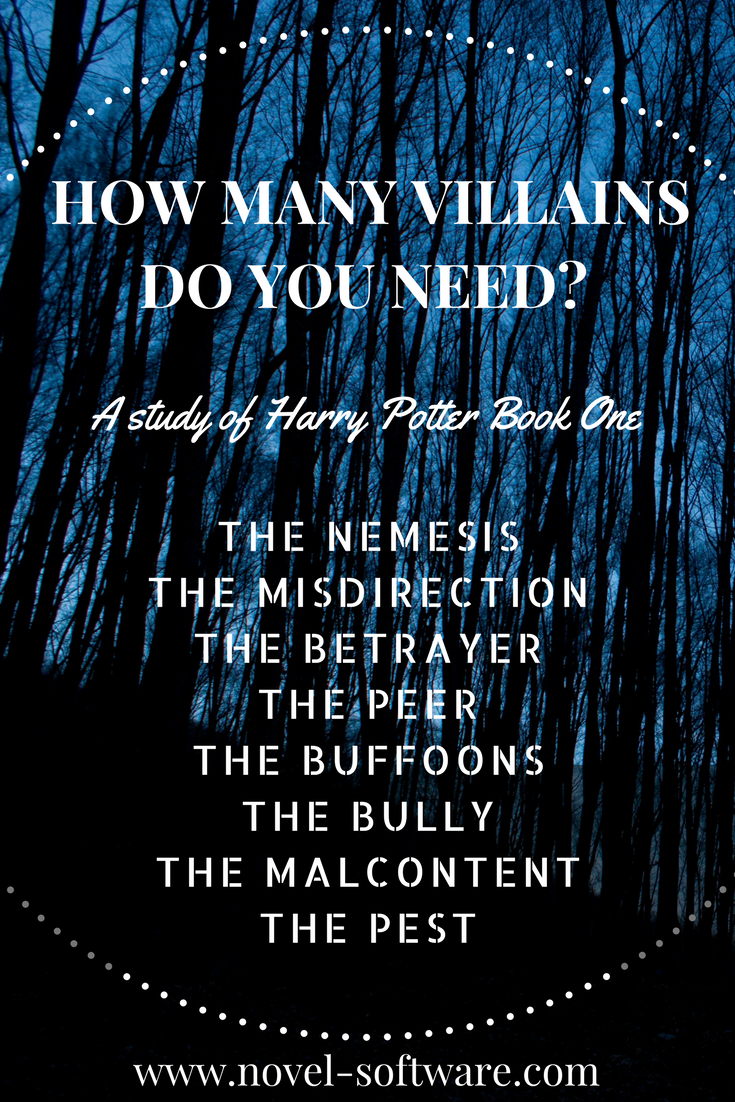
How many villains do you need? A study of Harry Potter Book One
We all know that a good story needs a good antagonist – someone to push the hero to their very limits.
But have you considered that you might need multiple villains?
Note – as an analysis, this article necessarily contains multiple spoilers for Harry Potter and the Philosopher’s Stone. If this is going to be a problem for you, don’t read this article.
In Harry Potter and the Philosopher’s Stone (the Sorcerer’s Stone to you Americans), JK Rowling has more than half a dozen antagonists – over ten if you count them very broadly.
In this article we’ll take a look at who each of these villains are, and what makes them and their role unique.
The Nemesis – Voldemort
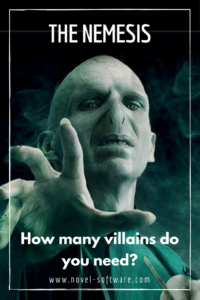
Voldemort is Harry’s nemesis, his arch enemy. He is the biggest bad throughout the entire series of stories, and is arguably an incarnation of the purest evil, with no redeeming qualities. He is powerful, infamous throughout the wizarding world and he has a personal grudge against Harry.
While he is frequently mentioned throughout the first book, he is not physically present (as far as the reader knows) until the very end. Rowling deliberately keeps him as a looming background threat by dropping hints about his horrific acts of the past, without actually bringing him on stage. A vague, formless evil is often much more sinister and unsettling than a tangible one that you can get to grips with.
The Authority / The Misdirection – Snape
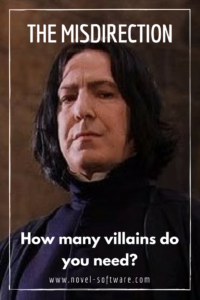
As Voldemort is not around on a day to day basis for most of Harry’s first year at Hogwarts, Professor Snape takes the role of primary antagonist throughout the book. Snape has the power to make Harry’s life difficult, and makes no secret of his hatred for him.
Everything about Snape oozes evil, from his looks to his voice to his unfair, victimising attitude. If the story was as simple as that, and Snape did turn out to be the ‘baddie’ that Harry and his buddies assume him to be throughout the story, then the result would have been rather dull. However, Rowling turns the tables and reveals Snape to have been trying to save Harry all along, lifting Snape from being the most obvious to the most surprising character.
Being a constant target for Harry’s suspicions creates loud misdirection, as Harry repeatedly jumps to the correct conclusion about what’s going on, but pins it on the wrong person. This allows the real betrayer to continually be present but unnoticed. Throughout the book, whenever something suspicious happens, Snape is front and centre, but Quirrell is also mentioned, but only as if a passing, incidental afterthought.
The Betrayer – Quirrell
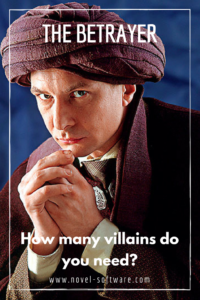
Quirrell is the true baddie of the Philosopher’s Stone, as a vessel for the nemesis, Voldemort. And as in all the greatest mystery stories, he is under your nose the whole time, but the last person you would suspect.
He comes across as anxious, fearful and utterly harmless. Barely able to stand up to his own shadow, let alone carry out evil plans or wrangle trolls. Nonetheless, as mentioned above, whenever something suspicious happens, he is always somewhere in the background.
The Peer / The Bully – Draco Malfoy
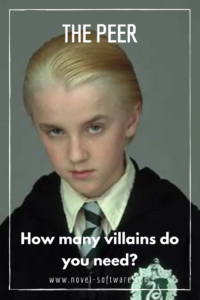
Supporting Snape in the day to day victimisation of Harry is Draco, who is different in that he is technically Harry’s peer. Unlike Snape, he has no position of authority with which to bully or punish Harry, but he does his best with what he’s got at his disposal.
Rowling builds our dislike for Draco by making him snobbish, cruel and mean. Like all bullies he’s also a coward, only confronting Harry when he has his meaty cronies to back him up.
The Buffoons – Mr and Mrs Dursley
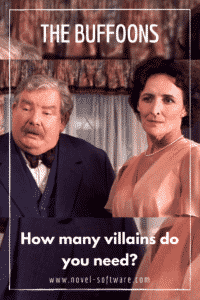
Only being present at the beginning and very end of the novel, Rowling is able to make Mr and Mrs Dursley quite extreme caricatures for comic effect.
Like Snape, they have official authority over Harry, which means they have the power to make his life difficult and order him around, and there’s not a lot he can do about it. However, as they come across as quite ridiculous and over the top, we don’t feel the same sense of evil or that they are particularly sinister.
They fulfil the role of ensuring Harry is up against it from the very first page, before the real villains turn up, but their exaggerated quality means their presence feels quite light-hearted, allowing the darkness and pressure to build over the course of the book.
The Bully – Dudley
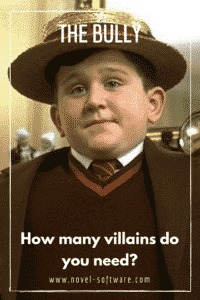
Like his parents, Dudley is a comic character, extremely over the top.
He is a bully, but in contrast to Draco, he has more brawn than brains. He’s quite happy to tussle personally with Harry, but is easily outwitted by the hero. Despite having all the advantages, he is not much of a match for Harry – Rowling starts us off with lower level challenges, then raises the stakes and the challenge level of the antagonists as the book progresses.
The Malcontent – Filch
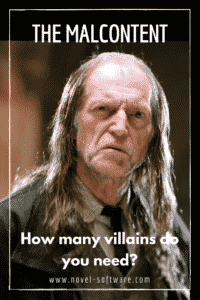
Filch doesn’t have anything against Harry personally, he just hates everyone. Like Snape, his appearance, voice and attitude all powerfully support his character as general nasty piece of work.
He ostensibly has some authority, but never comes across as having any power, and he is more of a nuisance than a real antagonist. His antagonistic duty is to be omnipresent – his job gives him the justification to be anywhere at any time, which means he can get Harry into trouble when it would be inappropriate for other antagonists to do so, either because they would have to be crow-barred into that position, or it would muddy their story arc.
The Pest – Peeves

Speaking of nuisances, Peeves is another general antagonist, a character who enjoys making life difficult for everyone, and Harry is no exception. He can pop up just to throw an insult, a projectile or a spanner in the works.
Additional antagonists
Centaurs
One of the centaurs actively helps Harry, but the other two try to obstruct that help, and have clear hostility towards Harry. They aren’t really ful-on antagonists, but they add another layer of antagonism to Harry’s story.
The whole school
After Harry and his friends are responsible for losing enough points to drop Gryffindor into last place, the entire school turns against him. Again, not a proper antagonist as it’s only temporary and it’s not a clearly defined character, but being hated by a large group of people certainly makes his life more difficult and miserable.
Summary
So, it’s obvious and Rowling isn’t content to pit her hero against a single antagonist, or even a few. She creates multiple villains, of varying levels of evil and strength, and takes care to throw in a few twists to their characters. As well as the main baddies, there are lower level baddies that either aren’t working directly against the hero but still thwart him, and some passing negative vibes just to make sure it’s layered on good and thick.
How many antagonists does your novel have?
Do you think all stories need as many as this? Or is it overkill?
How many antagonists do your favourite novels have?
